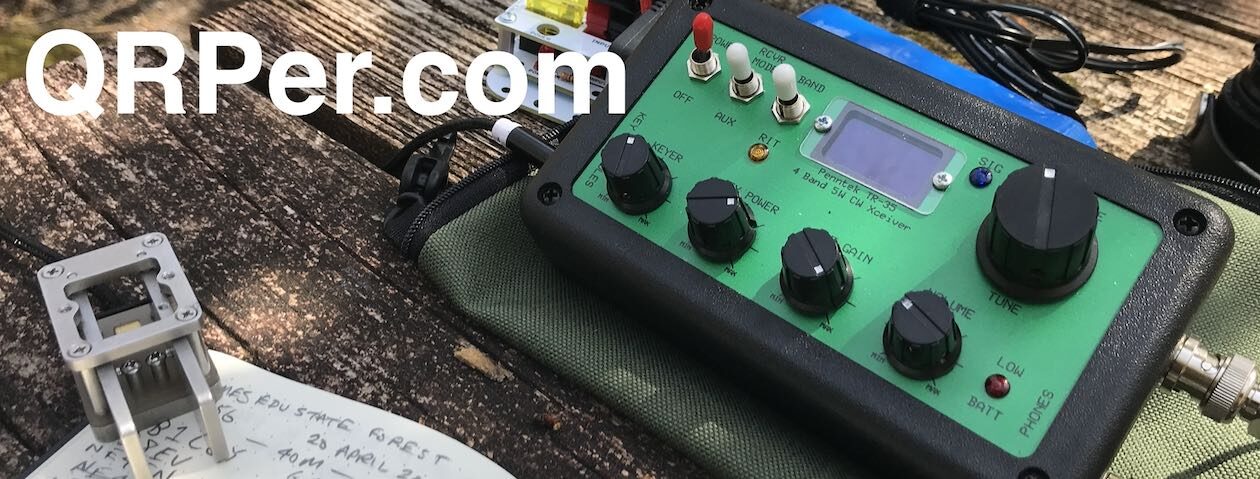Many thanks to Alan (W2AEW) for the following guest post:
Trapped EFHW antenna story (it’s all Vince’s fault)
by Alan (W2AEW)
One of my favorite antennas to use for POTA activations is a 40m EFHW wire. When properly tuned and deployed, it can be used on 40, 20, 15 and 10m without the use of a tuner (although, I really don’t mind using a tuner when I need to). Most of my activations are on 40 and 20m, so those bands are covered easily. It can be used successfully as a sloper, an inverted vee, or a combination of these (whatever the trees or support structures allow). It is efficient, inexpensive to build, lightweight and effective.
There are a few downsides to this antenna. The first is that it is approximately 68 feet (almost 21 meters) long. That’s a lot of wire to get in the air. Some POTA sites just don’t have that much room or support structures to effectively use this antenna. Another downside is that it doesn’t naturally support operation on the 30m band, another favorite of mine.
A few weeks ago, I watched a video from my friend Vince VE6LK entitled: “Discover the secret ingredients to build a trapped EFHW antenna”. This piqued my interest…
The video introduces a design for a 40/30/20m trapped EFHW. The fact that it covers the three bands I use the most, and would be shorter than my trusty full-sized 40m, and give me 30m to boot, got me excited to learn more.
Vince used a pair of traps (30m and 20m) that are offered in kit form by Tim Sherry, N7KOM. Here is a link to kit on Etsy.

These are exclusively for use at QRP power levels – perfect for my application. I placed my order immediately after watching the video. The build instructions are very detailed, including how to tune the traps, which is critical in getting the antenna to work.

He also used a 49:1 UNUN from SparkPlugGear. I’ve had one of these in my POTA kit for a while, but only used it occasionally. This was another good reason to proceed with this antenna build.
Of course, you could also use the QRP UNUN kit from KM4CFT that I made a video about earlier this year.
I created a video that showed how to assemble and tune the traps. Tuning can be a little tricky, and then stabilizing the turns/spacing to preserve the tuning is critical – not hard, just takes a bit of patience.
With the traps built and tuned, the next step would be to build and tune the antenna itself.
I was able to find the time this weekend to do just that, and make a video of the process.
Details of the resulting wire segment lengths are in the video. It is important to note that if you decide to build this antenna, your wire lengths will likely vary from mine. Several factors will effect the resulting lengths (details of the UNUN used, the trap construction, etc.). My video goes through the process I used to build, tune and test the antenna.
“The proof is in the pudding” as they say. It was time to actually run a POTA activation with this antenna. The overall length of the antenna was about 43 feet (about 13.1 meters), which is about 2/3rds the length of the 40m EFHW. This opens the possibility of using my 12 meter Spiderbeam mast (video review) as a support rather than just relying on a tree branch.
The weather here in NJ has been oppressively hot and humid with heat indexes over 100F, so I opted for a morning activation, before the heat really built up. The intent was to get some contacts on all three bands, even though 20m probably wouldn’t be very active.
I setup at my “home” park – Washington Rock State Park, US-1635. I decided to setup the Spiderbeam mast as the support for the new antenna:

 The rig was my trusty KX2 with the BamaTech TP-III paddles:
The rig was my trusty KX2 with the BamaTech TP-III paddles:
 I only had about an hour to dedicate to operating before the family activities for the day, so I figured I’d start on 40m and get most of the “ten” there first, then move on to pick up a few on 30m and 20m.
I only had about an hour to dedicate to operating before the family activities for the day, so I figured I’d start on 40m and get most of the “ten” there first, then move on to pick up a few on 30m and 20m.
I was able to put 14 contacts in the log, under “so-so” band conditions, which at least a few on each band, several of which were park-to-park contacts.
 Here’s the map of the “reach” that the new antenna had during this short activation:
Here’s the map of the “reach” that the new antenna had during this short activation:
 Overall I am quite pleased with the antenna’s performance. The near ideal band coverage for my typical activations, and the ease of deployment compared to the full-sized 40m EFHW make this antenna a great addition to my POTA kit. I suspect it will get a lot of use!
Overall I am quite pleased with the antenna’s performance. The near ideal band coverage for my typical activations, and the ease of deployment compared to the full-sized 40m EFHW make this antenna a great addition to my POTA kit. I suspect it will get a lot of use!
Resources:
- Tim’s (N7KOM) Etsy Store
- SparkPlugGear
- Vince’s (VE6LK) YouTube Channel and Website
- Alan’s (W2AEW) YouTube Channel


















































